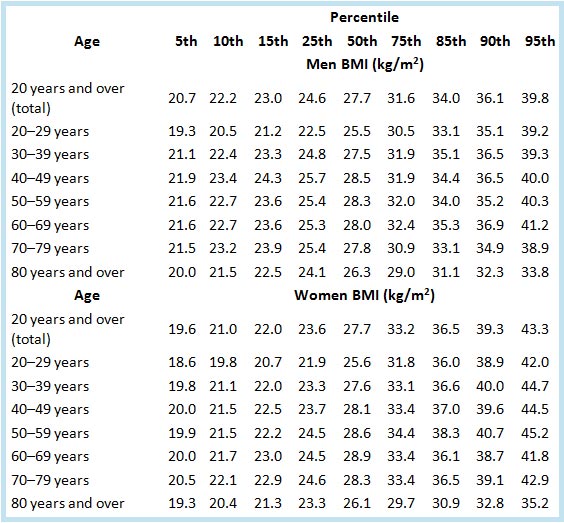Index Of Body Weight
Index of body weight or commonly referred to as body mass index abbreviated as BMI is a quantitative measurement which is derived from the height and the mass (weight) of an individual. Mathematically, BMI is calculated through two very simple steps. First, divide the mass of the individual with their height. After that, divide the quotient with the height again. The final result is the BMI of the individual. Since the units involved in the calculations do not cancel out, the BMI has got units. The SI unit for mass is kilogram (kg) and the height which can be taken to be length is measured in metres (m). Hence the resultant unit for BMI is kg/m2. The kg/m2 is the universally accepted unit of expressing the BMI of an individual throughout the world.
Sample calculation of BMI
Consider a case where we have an individual with a body mass of 54kg and with a height of 1.5 metres. To determine the body mass index, proceed as follows:
Divide the mass of the individual with the height, I.e, 54 divide by 1.5. The answer is 36. Now, divide the answer with the height. Which translates to 36 divide by 1.5. The end result is 24. Therefore the body mass index of the individual is 24 kg/m2.
As it can be seen, the BMI can be calculated in a single step. This can be done by dividing the mass of an individual with the square of their height. For instance, in the example above, where the mass of the individual is 54kg and the height is 1.5 m, then the body mass index can be calculated in one step as follows:
Body Mass Index= mass divide by square of height
Hence; BMI= 54 divide by 1.52. This still brings a BMI value of 24 kg/m2
IMPLICATION OF BODY MASS INDEX NUMBER
In the earlier schools of thoughts, the BMI number was known to be a quantifier of the fat an individual has in his/her body. As a result, it was believed that the larger the value of the BMI, the more fat an individual has. The reverse was also true, the lesser the value of BMI the lesser the fat in the body. Even today, the BMI is still is used as a tool for screening, in which case the number helps to determine whether the weight of an individual is putting him/her at risk of health problems more so diabetes, hypertension and cancer.
Alternative method of calculating BODY MASS INDEX
The BMI of an individual is not always calculated in the universal or standard units i.e kg/m2. There exists some cases where the derivatives of both mass and height are used in calculations. One such common derivative of mass which is used is the pound, and is used hand in hand with the inch which is a derived unit of length (height). When calculated in pounds per square inches, the formula for calculating body mass index slightly changes. First, the weight in pounds is multiplied by a constant: 703 before it is divided by the square of the height in inches.
Example of Calculation
If an individual weighs 120 pounds and he/she is 63 inches tall, then his or her body mass index is calculated as follows:
Body mass index= (weight in pounds multiply by 703) divided by (square of height in inches). Hence;
BMI= (120*703) divide by (632) = 21.3
Universal BMI and Interpretation
It was necessary to have a common point of reference for interpretation of BMI values. As a result, many nations and scholars after conducting several significant studies proposed some BMI range of values which could imply different meanings. It is however worth to not that reference was made mostly to obesity when this values were being proposed. These are the by then range of values of body mass index and their corresponding implications.
- A person was considered to be underweight if their BMI value is less than 18.5
- For a person to be said to be of normal weight, he/she was supposed to have a body mass index (BMI) of between 18.5 to 24.9.
- For an individual to be said to be overweight, their BMI was ought to be between 25 and 29.9. Such an individual was considered to be at a higher risk of contracting diabetes, heart diseases and cancer.
- Body mass index of 30 or more signified that an individual is obese. The person is most likely to suffer from diabetes, high blood pressure and heart attack.
International Variations of Body Mass Index
Due to differences in climatic conditions among other differences, some countries adopted their own body mass indices which are different from the universal BMI. Some of the countries are Hong Kong, Japan
Hong Kong
- A BMI of up to 18.5 is considered underweight
- The BMI of a normal person is in the range of 18.5 to 23 kg/m2
- An individual with a BMI of between 23-25 is considered overweight and at risk
- An individual with a BMI of 25-30 is overweight and moderately obese
- When the BMI is 30 and above, the individual is overweight and is severely obese.
Japan
- A BMI of up to 18.5 kg/m2 is assigned to an underweight individual.
- The normal range is set at 18.5-25 kg/m2
- Level 1 Obesity starts at 25 and goes all the way to 30 kg/m2
- Level 2 obesity is from 30-35
- Obese Level 3 is in the range of 35-40
- BMI beyond 40 kg/m2 is an indicator of Obese Level 4
Singapore
Studies that were conducted amongst Asian populations proved that majority of the Asian populations, including Singaporeans, generally have higher proportion of body fat and have increased risk for heart diseases and diabetes mellitus, as compared with their Caucasian counterparts at the same BMI. The BMI cut-offs, for this reason, are presented with an emphasis on health risk instead of weight. The following guidelines are thus being used in Singapore:
| Health Risk | BMI (kg/m2) |
|---|---|
| Risk of developing problems such as nutritional deficiency and osteoporosis | under 18.5 |
| Low Risk (healthy range) | 18.5 to 23 |
| Moderate risk of developing heart disease, high blood pressure, stroke, diabetes | 23 to 27.5 |
| High risk of developing heart disease, high blood pressure, stroke, diabetes | over 27.5 |
United States of America's Body mass Index
In USA, the BMI is thought to be gender based and varies with age. Below is a table that has the body mass index values for USA citizens with respect to gender and age range.
Body Mass Index values for males and females aged 20 and over, and selected percentiles by age: United States

Following the values displayed in the table above, quite a large population of US citizens have been diagnosed as overweight consequently leading to a tremendous increase in the sales of products that assist in weight loss. Also, there is a debate on the definition of an underweight woman. On their part, doctors argue that any BMI number between below 18.5 and not exceeding 20 is underweight. In fact, the most commonly value stated is 19. Starvation is usually defined by a body mass index of 15 and below. An informal criteria is used for the diagnosis of anorexia nervosa using body mass index when the body mass index is below 17.5.
The Body mass Index for Children and Teens
Calculations for body mass index of children and teens age 2-20 years are similar to those of adults. However, after obtaining the BMI value, the value is compared against an established graph which contains different curves representing different body mass indices. The curves on the graph could have different colors and well defined ranges for underweight, normal weight, overweight and obese. This is set in percentiles. A sample of such a graph is shown below.

APPLICATIONS OF BODY MASS INDEX
The BMI values have been put into a variety of uses. Some of these uses are still applicable while others have been faded out by improvements.
- In public health, body mass index has been used as the standard in recording of statistics of obese people. Although not very accurate, by making use of consensus data, it can be used to find a more accurate solution.
- In the clinical field of practice, the body mass index is used to classify sedentary people into categories of obese, overweight or underweight. These are some exceptions to the elderly, children and the athletes while making the classification. In some areas such as the US, the body mass index is taken to be a measure of underweight.
- Some states and countries have established rules regarding body mass index values. For instance, Spain, Italy, Israel and France set at a low that prohibits the use of fashion show models who have a body mass index of below 18. For Israel, there is a ban against BMI below 18.5. These legislations come as part of the efforts to fight against anorexia common among fashion lovers and models.
Limitations
Mathematicians argue that the error involved in the calculation of body mass index is significant and that there is need for a revision on the same since it makes the whole thing less useful for health evaluation.
The BMI is said to be misleading. Taller people are often convinced to believe that they are fatter than they really are, while shorter people are convinced to believe that they are thinner than they are.
Does not put into account the variations in shape of individuals. Two persons can have the same height and the same weight. However, their complexions may be significantly different. For instance, one can be tall and with a wide frame. Another one may be tall, probably with the same height as the first one, but with a small frame. Generally, a person with a small frame is most likely having more fat than optimal although their body mass index values may indicate that they are normal. In the same way, tall or people with large frames may be classified to be overweight while even though they may be having a low body fat.
BMI does not put into account the differences between muscle mass and fat mass. People who are very fit or athletic, have a high muscle mass and their BMI can classify them as overweight yet their body fat could be as low as 10%.
The above limitations clearly show that the weight and height of an individual should not be used as the sole measurements to determine the health of an individual. Other measurements such as waist circumference, waist to hip and mid upper arm circumference (MUAC) should be used for more accurate results.


